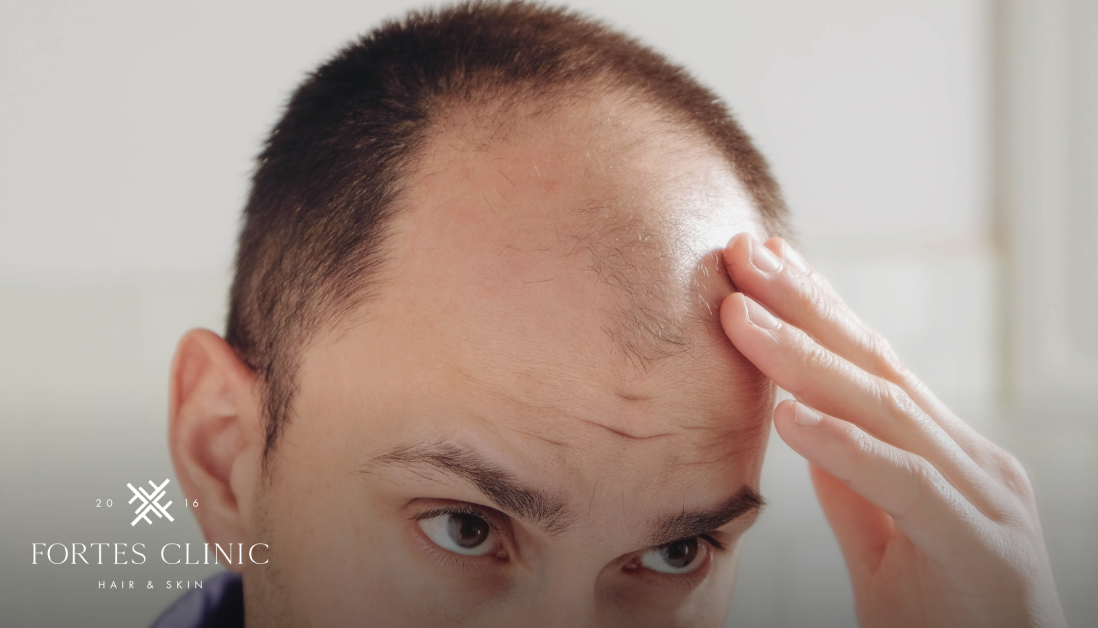Introduction
Male pattern baldness is a common condition that affects a significant number of men worldwide. It can have a profound impact on a person’s self-esteem and overall well-being. In this article, we will explore the intricacies of male pattern baldness, including its causes, signs, and treatment options. By understanding this condition better, men can make informed decisions about managing and coping with hair loss.
Understanding Male Pattern Baldness
Male pattern baldness, also known as androgenetic alopecia, is a specific pattern of hair loss that primarily affects men. It typically follows a predictable pattern, starting with a receding hairline and thinning of hair on the crown. To comprehend male pattern baldness fully, it’s essential to understand the natural hair growth cycle.
Hair Growth Cycle
Our hair goes through a continuous cycle of growth, rest, and shedding. The growth phase, known as anagen, lasts for several years, during which the hair follicles produce new hair strands. This is followed by the catagen phase, a brief transitional period, and then the telogen phase, where the hair follicles rest before shedding the old hair. Male pattern baldness disrupts this cycle, leading to hair follicles shrinking over time.
Causes of Male Pattern Baldness
Male pattern baldness can be attributed to a combination of genetic, hormonal, and environmental factors. Understanding these causes can shed light on why some men are more prone to hair loss than others.
Genetic Factors
Genetics plays a significant role in male pattern baldness. If your close family members, such as your father or grandfather, have experienced hair loss, you may be genetically predisposed to it. The inheritance of certain genes can make your hair follicles more sensitive to the hormone dihydrotestosterone (DHT), leading to their shrinkage.
Hormonal Factors
DHT, a byproduct of testosterone, is a hormone responsible for the development of male characteristics. In individuals with a genetic predisposition, DHT can bind to the hair follicles’ receptors, causing them to shrink and produce thinner, shorter hair strands. This hormone sensitivity varies from person to person and determines the extent of hair loss.
Age
As men age, the likelihood of experiencing male pattern baldness increases. It is estimated that around two-thirds of men will experience some degree of hair loss by the age of 35, and by the age of 50, approximately 85% of men will have significant hair thinning.
Medical Conditions
Certain medical conditions, such as thyroid disorders and autoimmune diseases, can contribute to hair loss. Additionally, treatments like chemotherapy for cancer and some medications may cause temporary or permanent hair loss.
Signs and Symptoms of Male Pattern Baldness
Male pattern baldness typically follows a distinctive pattern, which can help identify and differentiate it from other types of hair loss.
Receding Hairline
One of the primary signs of male pattern baldness is a receding hairline. The hairline gradually moves higher on the forehead, forming an “M” shape.
Thinning Hair on the Crown
As the condition progresses, men often notice thinning of hair on the crown or top of the scalp. This thinning can eventually lead to partial or complete baldness in that area.
Hair Loss Progression
Male pattern baldness usually starts with the hairline recession and crown thinning, and over time, the two areas merge, resulting in a more extensive balding pattern. However, hair loss varies among individuals, and the progression can be slow or rapid.
Norwood Scale Classification
To assess and classify the extent of male pattern baldness, doctors often use the Norwood scale. This scale categorises the hair loss patterns into various stages, ranging from minimal hair loss to severe baldness.
Diagnosing Male Pattern Baldness
If you suspect that you are experiencing male pattern baldness, it is crucial to consult a healthcare professional for an accurate diagnosis. The following methods are commonly used to diagnose this condition.
Medical History and Physical Examination
During the initial consultation, your doctor will review your medical history and inquire about any family history of hair loss. They will also examine your scalp and hair to assess the pattern and extent of hair loss.
Scalp Biopsy
In some cases, a scalp biopsy may be performed to rule out other causes of hair loss. A small sample of your scalp skin is taken and examined under a microscope to determine the underlying cause.
Blood Tests
Blood tests may be recommended to check for any underlying medical conditions, such as hormonal imbalances or nutritional deficiencies, that could contribute to hair loss.
Treatment Options for Male Pattern Baldness
While male pattern baldness cannot be completely cured, several treatment options can help slow down hair loss, promote hair regrowth, and improve the appearance of thinning hair.
Medications
- Finasteride (Propecia): This prescription medication works by reducing the levels of DHT in the scalp, thereby slowing down hair loss and promoting regrowth.
- Minoxidil (Rogaine): Available over the counter, minoxidil is a topical solution or foam that is applied directly to the scalp. It stimulates hair follicles, prolongs the hair growth cycle, and can lead to increased hair density.
Hair Transplantation
Hair transplantation is a surgical procedure that involves transferring hair follicles from the back or sides of the scalp (the donor area) to the balding areas (the recipient area). It offers a permanent solution to hair loss, providing natural-looking results.
Low-Level Laser Therapy (LLLT)
LLLT utilises red light wavelengths to stimulate hair growth at the cellular level. It is a non-invasive treatment option that can be performed at home using specialized devices or in a clinic setting.
Platelet-Rich Plasma (PRP) Therapy
PRP therapy involves extracting a small amount of blood from the patient, separating the platelet-rich plasma, and injecting it into the scalp. The growth factors present in the plasma stimulate hair follicles and promote hair regrowth.
Lifestyle Changes and Hair Care Tips
In addition to medical treatments, certain lifestyle changes and hair care practices can help manage male pattern baldness and maintain healthy hair.
Healthy Diet and Nutrition
Eating a balanced diet rich in vitamins, minerals, and proteins is essential for promoting hair health. Incorporate foods like fruits, vegetables, whole grains, lean proteins, and healthy fats into your daily meals.
Stress Management
Excessive stress can contribute to hair loss and worsen male pattern baldness. Adopt stress management techniques such as exercise, meditation, and relaxation exercises to reduce stress levels.
Gentle Hair Care Practices
Avoid aggressive brushing, excessive heat styling, and tight hairstyles that can put stress on the hair follicles. Use gentle shampoos and conditioners suitable for your hair type, and avoid overwashing to maintain the natural oils that nourish the scalp.
Avoiding Harsh Styling Products
Certain hair styling products containing harsh chemicals can damage the hair and worsen hair loss. Opt for milder, natural alternatives and minimise the use of gels, waxes, and sprays.
Coping with Male Pattern Baldness
Coming to terms with male pattern baldness and its impact on your appearance can be challenging. However, there are strategies and resources available to help you cope with this condition.
Acceptance and Positive Body Image
Embrace the changes in your appearance and focus on building a positive body image. Remember that baldness does not define your worth or attractiveness as a person.
Psychological Support
Seeking support from loved ones or joining support groups can provide a safe space to share experiences and emotions related to hair loss. Additionally, consider talking to a mental health professional who specialises in body image issues or hair loss-related concerns.
Hair Styling Options and Tips
Explore different hair styling options that can complement your balding pattern and enhance your confidence. Consulting a hairstylist who specialises in working with thinning hair can provide valuable guidance on suitable hairstyles and grooming techniques.
Prevention of Male Pattern Baldness
While you cannot entirely prevent male pattern hair loss, certain measures can help slow down its progression or delay its onset.
Early Intervention
If you notice signs of male pattern baldness, seek treatment as early as possible. Early intervention can significantly improve the effectiveness of medical treatments and promote better hair retention.
Understanding Risk Factors
Being aware of the risk factors associated with male pattern baldness, such as genetics and age, can help you take proactive steps to manage and minimise their impact.
Regular Scalp Care
Maintaining good scalp hygiene by keeping it clean and free from excess oil or dandruff can contribute to overall hair health. Use gentle cleansers and avoid excessive scratching or harsh scalp treatments.
FAQs About Male Pattern Baldness
Can You Reverse Male Pattern Baldness?
While it is not possible to completely reverse male pattern baldness, certain treatments can slow down hair loss and promote regrowth. It is important to manage expectations and consult with a healthcare professional to determine the most suitable options for your specific condition.
Is Male Pattern Baldness Hereditary?
Yes, male pattern baldness has a strong genetic component. If you have close family members with this condition, you may be more likely to experience it as well.
Can Stress Cause Male Pattern Baldness?
While stress itself may not directly cause male pattern baldness, it can exacerbate the condition or contribute to hair loss. Managing stress levels and adopting healthy coping mechanisms is important for overall hair health.
Are Natural Remedies Effective in Treating Male Pattern Baldness?
While some natural remedies and supplements claim to promote hair growth, there is little evidence that supports their effectiveness. It is best to consult with a healthcare professional for evidence-based treatment options.
Conclusion
Male pattern baldness is a widespread condition that affects many men globally. Understanding its causes, signs, and treatment options can empower individuals to make informed decisions about managing their hair loss. Whether through medical interventions, lifestyle adjustments, or psychological support, it is possible to navigate male pattern baldness with confidence and maintain a positive self-image.



